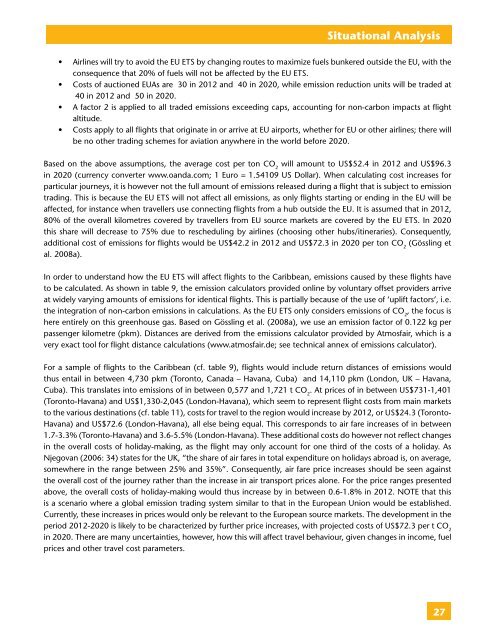Tourism & CC Challenges & Opportunities - Global Commons Institute
Tourism & CC Challenges & Opportunities - Global Commons Institute
Tourism & CC Challenges & Opportunities - Global Commons Institute
You also want an ePaper? Increase the reach of your titles
YUMPU automatically turns print PDFs into web optimized ePapers that Google loves.
Situational Analysis<br />
• Airlines will try to avoid the EU ETS by changing routes to maximize fuels bunkered outside the EU, with the<br />
consequence that 20% of fuels will not be affected by the EU ETS.<br />
• Costs of auctioned EUAs are €30 in 2012 and €40 in 2020, while emission reduction units will be traded at<br />
€40 in 2012 and €50 in 2020.<br />
• A factor 2 is applied to all traded emissions exceeding caps, accounting for non-carbon impacts at flight<br />
altitude.<br />
• Costs apply to all flights that originate in or arrive at EU airports, whether for EU or other airlines; there will<br />
be no other trading schemes for aviation anywhere in the world before 2020.<br />
Based on the above assumptions, the average cost per ton CO 2<br />
will amount to US$52.4 in 2012 and US$96.3<br />
in 2020 (currency converter www.oanda.com; 1 Euro = 1.54109 US Dollar). When calculating cost increases for<br />
particular journeys, it is however not the full amount of emissions released during a flight that is subject to emission<br />
trading. This is because the EU ETS will not affect all emissions, as only flights starting or ending in the EU will be<br />
affected, for instance when travellers use connecting flights from a hub outside the EU. It is assumed that in 2012,<br />
80% of the overall kilometres covered by travellers from EU source markets are covered by the EU ETS. In 2020<br />
this share will decrease to 75% due to rescheduling by airlines (choosing other hubs/itineraries). Consequently,<br />
additional cost of emissions for flights would be US$42.2 in 2012 and US$72.3 in 2020 per ton CO 2<br />
(Gössling et<br />
al. 2008a).<br />
In order to understand how the EU ETS will affect flights to the Caribbean, emissions caused by these flights have<br />
to be calculated. As shown in table 9, the emission calculators provided online by voluntary offset providers arrive<br />
at widely varying amounts of emissions for identical flights. This is partially because of the use of ‘uplift factors’, i.e.<br />
the integration of non-carbon emissions in calculations. As the EU ETS only considers emissions of CO 2<br />
, the focus is<br />
here entirely on this greenhouse gas. Based on Gössling et al. (2008a), we use an emission factor of 0.122 kg per<br />
passenger kilometre (pkm). Distances are derived from the emissions calculator provided by Atmosfair, which is a<br />
very exact tool for flight distance calculations (www.atmosfair.de; see technical annex of emissions calculator).<br />
For a sample of flights to the Caribbean (cf. table 9), flights would include return distances of emissions would<br />
thus entail in between 4,730 pkm (Toronto, Canada – Havana, Cuba) and 14,110 pkm (London, UK – Havana,<br />
Cuba). This translates into emissions of in between 0,577 and 1,721 t CO 2<br />
. At prices of in between US$731-1,401<br />
(Toronto-Havana) and US$1,330-2,045 (London-Havana), which seem to represent flight costs from main markets<br />
to the various destinations (cf. table 11), costs for travel to the region would increase by 2012, or US$24.3 (Toronto-<br />
Havana) and US$72.6 (London-Havana), all else being equal. This corresponds to air fare increases of in between<br />
1.7-3.3% (Toronto-Havana) and 3.6-5.5% (London-Havana). These additional costs do however not reflect changes<br />
in the overall costs of holiday-making, as the flight may only account for one third of the costs of a holiday. As<br />
Njegovan (2006: 34) states for the UK, “the share of air fares in total expenditure on holidays abroad is, on average,<br />
somewhere in the range between 25% and 35%”. Consequently, air fare price increases should be seen against<br />
the overall cost of the journey rather than the increase in air transport prices alone. For the price ranges presented<br />
above, the overall costs of holiday-making would thus increase by in between 0.6-1.8% in 2012. NOTE that this<br />
is a scenario where a global emission trading system similar to that in the European Union would be established.<br />
Currently, these increases in prices would only be relevant to the European source markets. The development in the<br />
period 2012-2020 is likely to be characterized by further price increases, with projected costs of US$72.3 per t CO 2<br />
in 2020. There are many uncertainties, however, how this will affect travel behaviour, given changes in income, fuel<br />
prices and other travel cost parameters.<br />
27
















